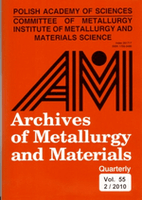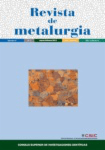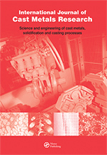
ARCHIVES OF METALLURGY AND MATERIALS
Scope & Guideline
Unlocking Innovations in Metals and Alloys
Introduction
Aims and Scopes
- Metallurgical Processes and Techniques:
The journal extensively covers various metallurgical processes such as casting, welding, and heat treatment, providing insights into their effects on material properties and performance. - Material Characterization:
There is a strong emphasis on the characterization of materials using advanced techniques such as electron microscopy, X-ray diffraction, and mechanical testing to understand their microstructural and mechanical properties. - Innovative Material Development:
Research related to the development of new materials, including composites, alloys, and advanced coatings, is a core focus, aiming to enhance performance and sustainability. - Corrosion and Degradation Studies:
The journal includes studies on the corrosion resistance and degradation mechanisms of various materials, contributing to the understanding of their longevity and reliability in different environments. - Sustainable Practices in Material Science:
Research that explores sustainable practices in material production and recycling is increasingly prominent, reflecting the journal's commitment to environmental responsibility.
Trending and Emerging
- Additive Manufacturing and 3D Printing:
Research on additive manufacturing and 3D printing technologies is rapidly increasing, focusing on their applications in producing complex geometries and customized materials. - Nanomaterials and Nanocomposites:
The exploration of nanomaterials and nanocomposites is gaining traction, emphasizing their unique properties and potential applications in various industries. - Smart Materials and Functional Coatings:
There is a growing interest in smart materials and functional coatings, which respond to environmental stimuli or provide enhanced protective characteristics. - Recycling and Waste Management in Metallurgy:
Research on recycling processes and waste management in metallurgy is trending, highlighting the importance of sustainability and resource efficiency. - Computational Materials Science:
The integration of computational methods in materials science research is on the rise, enabling predictive modeling and simulations to complement experimental studies.
Declining or Waning
- Traditional Metallurgical Methods:
There has been a noticeable decrease in publications focusing solely on traditional metallurgical methods, such as basic casting and forging processes, as researchers increasingly explore advanced techniques. - Conventional Coating Techniques:
Research related to conventional coating techniques has diminished, likely due to the rise of novel coating technologies that offer enhanced performance and applicability. - Basic Materials Testing:
There is a waning interest in basic mechanical testing studies without innovative insights or applications, as the field moves towards more complex and integrated approaches.
Similar Journals

Acta Metallurgica Sinica-English Letters
Advancing Metallurgy: Bridging Theory and Practice.Acta Metallurgica Sinica-English Letters, published by the Chinese Academy of Sciences, Institute of Metal Research, is a premier international journal that has been fostering the advancement of knowledge in the fields of Industrial and Manufacturing Engineering and Metals and Alloys since its inception in 1997. With a commendable impact factor and ranking within the top quartiles (Q1) of leading Scopus categories, this journal serves as a vital platform for researchers and professionals to disseminate innovative research findings and groundbreaking methodologies. Notably recognized with a Scopus rank of #34 out of 176 in Materials Science and rank #81 out of 384 in Engineering, it provides a robust space for high-quality, peer-reviewed articles, thus bridging the gap between theoretical advancement and practical application in metallurgy and materials science. Although currently not an open-access journal, its rigorous editorial standards and comprehensive scope ensure that only the most impactful research contributes to the scientific community and industry advancements globally. Acta Metallurgica Sinica-English Letters is an essential read for anyone eager to stay informed on cutting-edge developments within these crucial domains.

METALLURGIA ITALIANA
Exploring the Depths of Metallurgical InnovationMETALLURGIA ITALIANA, an esteemed journal published by the ASSOCIAZIONE ITALIANA METALLURGIA, specializes in the fields of condensed matter physics, mechanics of materials, and metals and alloys. With a history spanning from 1969 to 2024, this Italian journal has consistently contributed to the scholarly conversation surrounding metallurgical sciences and materials engineering. Despite its Q4 ranking in several categories, the journal provides a critical platform for emerging research and advancements in metallurgy, encouraging interdisciplinary dialogue among academics, professionals, and students. Readers can benefit from valuable insights into the latest developments and applications in the field, supported by the journal's commitment to fostering academic rigor and innovation. While access options currently do not include open access, METALLURGIA ITALIANA remains a cherished resource for those dedicated to exploring the nuances of material properties and applications.

REVISTA DE METALURGIA
Fostering collaboration in the world of metallurgical science.REVISTA DE METALURGIA, published by the CONSEJO SUPERIOR INVESTIGACIONES CIENTIFICAS-CSIC in Spain, stands as a significant open-access journal since 1995 that focuses on the fields of condensed matter physics, materials chemistry, and the study of metals and alloys. With an ISSN of 0034-8570 and an E-ISSN of 1988-4222, this journal aims to disseminate innovative research findings and reviews that contribute to the understanding and advancement of metallurgical science. Although currently ranked in the fourth quartile across several relevant categories in Scopus, including Materials Science and Physics, its commitment to open access promotes the wider distribution of knowledge in these fields, ensuring that emerging findings are accessible to researchers, industry professionals, and students alike. The journal covers research from its earliest issues in 1968, maintaining a continuous archive that enhances its contributions to the scientific community. For those passionate about the complexities of material properties and behaviors, REVISTA DE METALURGIA serves as a platform for impactful scholarship and collaborative advancement.

METALURGIJA
Exploring the depths of metallurgy with global collaboration.METALURGIJA is a distinguished open-access journal published by the Croatian Metallurgical Society, dedicated to advancing the field of metallurgical sciences and engineering. With an ISSN of 0543-5846 and E-ISSN of 1334-2576, this journal has been serving the academic community since its inception, offering valuable insights into condensed matter physics, materials chemistry, mechanics of materials, and metals and alloys. As of 2023, it ranks in Q3 in the fields of condensed matter physics, materials chemistry, and mechanics of materials, and Q2 in metals and alloys, reflecting its engagement with contemporary research and emerging trends. The journal's open-access policy, in place since 2002, ensures that high-quality research is accessible to a global audience, fostering collaboration and knowledge sharing. Located in Zagreb, Croatia, METALURGIJA aims to bring together researchers, industry professionals, and students alike to contribute to systemic advancements in metallurgical research and applications, ultimately enhancing innovation within the materials science community.

METALLURGIST
Illuminating the Path of Metallurgical Excellence.METALLURGIST, published by SPRINGER, is a distinguished journal dedicated to advancing the field of metallurgy and materials science. With a rich history dating back to 1957, this journal serves as an essential platform for disseminating cutting-edge research encompassing a wide scope of topics, including condensed matter physics, materials chemistry, and the mechanics of materials. The journal's impact can be seen through its categorization in the Q4 and Q3 quartiles across various fields, indicating its significance in the global research landscape. Although it is not an open-access publication, METALLURGIST maintains high academic standards and attracts contributions that provide valuable insights into metals and alloys, offering researchers and professionals a wealth of knowledge that is pivotal for innovative developments in the materials sector. With its continued commitment to excellence, METALLURGIST aims to foster collaboration and engagement within the metallurgical community, making it a vital resource for students, researchers, and industry experts alike.

INTERNATIONAL JOURNAL OF CAST METALS RESEARCH
Advancing the Frontiers of Cast Metals KnowledgeInternational Journal of Cast Metals Research, published by Taylor & Francis Ltd, serves as a premier platform for the dissemination of cutting-edge research in the fields of Mechanical Engineering, Mechanics of Materials, and Metals and Alloys. With a commitment to advancing the understanding of cast metals, this peer-reviewed journal has achieved notable recognition, featuring a 2023 Q2 ranking in its respective categories and ranking 71st in the Materials Science field according to Scopus. Researchers and professionals will find a wealth of valuable insights through rigorous studies and innovative findings, reflecting the journal's goal of facilitating knowledge transfer and addressing contemporary challenges in material science. Furthermore, its accessible publication years from 1996 to 2024 ensure that it not only captures the evolution of technology in cast metals but also stands at the forefront of future developments. Ideal for academics and practitioners alike, the journal aims to foster collaboration and inspire new developments within the discipline.

TRANSACTIONS OF THE INDIAN INSTITUTE OF METALS
Advancing metallurgy through innovative research.TRANSACTIONS OF THE INDIAN INSTITUTE OF METALS is a premier journal published by Springer India, dedicated to the field of metallurgy and materials science. Established in 1969, this journal serves as a vital platform for researchers and professionals to disseminate their findings on metals and alloys, showcasing innovative studies and experimental techniques. With an impressive impact factor and categorized in the Q2 quartile for metals and alloys as of 2023, it ranks 70 out of 176 in its field according to Scopus, placing it in the 60th percentile. The journal maintains a robust reputation for fostering academic excellence, thus attracting contributions from both established and emerging scholars. Though not an open access publication, its well-curated content remains a crucial resource for advancing knowledge and technology in metallurgy. The journal's extensive operational history, particularly during notable converged years, underscores its enduring significance in the scientific community.

International Journal of Minerals Metallurgy and Materials
Pioneering Discoveries in Minerals and MetallurgyThe International Journal of Minerals Metallurgy and Materials, published by SPRINGER, stands as a prominent forum in the fields of minerals, metallurgy, and materials science. With an ISSN of 1674-4799 and an E-ISSN of 1869-103X, this journal has been disseminating high-quality research since its inception in 2009 and will continue to publish until 2024. Based in China, this journal supports Open Access options, maximizing the reach and impact of scholarly work. Enhanced by its impressive Scopus rankings, it holds a Q2 position in Geochemistry and Petrology and a Q1 ranking in Materials Chemistry, Mechanical Engineering, Mechanics of Materials, and Metals and Alloys for 2023. Such accolades reflect its continual commitment to advancing knowledge in these disciplines, making it essential reading for researchers, professionals, and students aiming to stay abreast of contemporary developments and innovative solutions in materials science.

Journal of the Japan Institute of Metals and Materials
Exploring innovations in metals and materials research.Journal of the Japan Institute of Metals and Materials (ISSN: 0021-4876, E-ISSN: 1880-6880) serves as a vital academic platform under the esteemed auspices of the Japan Institute of Metals & Materials. This journal, with a rich publication history dating back to 1937, focuses on advancing knowledge in the fields of metallurgy, materials science, and engineering, making it an important resource for researchers, professionals, and students alike. Although the journal has been categorized in Q4 quartiles across several subject areas, including Condensed Matter Physics and Materials Chemistry, it plays a critical role in disseminating essential findings and fostering discussion regarding innovations in metal and materials research. Notably, the journal operates without open access, which encourages targeted readership engagement through its curated content. Based in Japan, it continues to contribute significantly to the academic community by bridging the gap between scientific inquiry and practical application in materials technology.

Journal of Materials Science & Technology
Exploring the Frontiers of Material TechnologiesThe Journal of Materials Science & Technology, published by JOURNAL MATER SCI TECHNOL in China, is a leading forum for the latest research in the multidisciplinary field of materials science. With the ISSN 1005-0302 and E-ISSN 1941-1162, this esteemed journal boasts an impressive impact factor and has established itself as a vital resource for professionals, researchers, and students alike. Covering a wide range of topics, including ceramics, composites, materials chemistry, mechanical engineering, and polymers, it has achieved a coveted Q1 ranking in multiple categories as of 2023, reflecting its position in the top tier of scholarly publications. Notably, the journal excels in its Scopus ranks, placing within the top 5% in categories such as Metals and Alloys and Mechanical Engineering. Aiming to foster knowledge and innovation in material development and application, the journal is committed to facilitating groundbreaking research and collaborations that propel the field forward. With its convergence of insights from 1993 to 2025, the Journal of Materials Science & Technology remains an indispensable resource for the advancement of materials science.